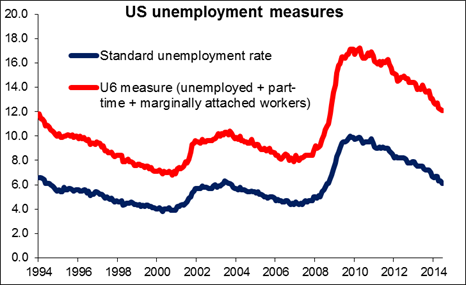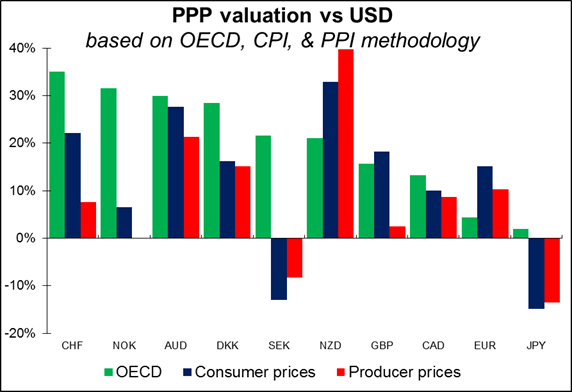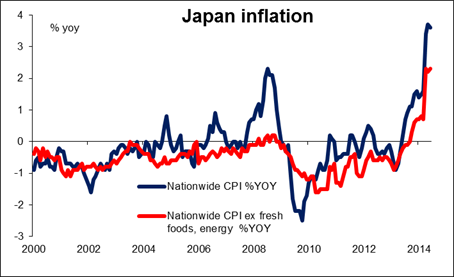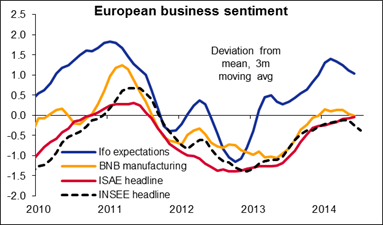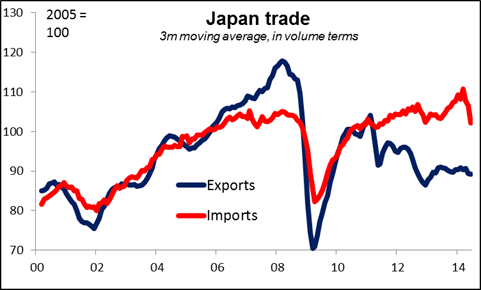·
Ukraine
crisis sets the tone
The crisis in Ukraine dominated activity Monday. The dollar gained all around
against its G10 counterparts (even JPY) as the US currency’s safe-haven appeal
came to the fore amidst general risk aversion. Stocks fell while oil and
government bond prices rose. Gold was little changed, however.
·
Only two of the 15 EM
currencies that we track -- RUB and CZK – were noticeably lower vs USD, while
several gained substantially, including THB, TRY, IDR and ZAR. This shows there
is little if any contagion effect from the Ukraine crisis on other EM markets.
The gains of the high-yielding currencies suggest that carry trades are not
being affected (yet).
·
Outlook
for the crisis: The latest
round of US sanctions against Russia, targeting publicly traded companies, is a
clear escalation from previous rounds. While there was some division between
the US and Europe on the scale of sanctions last week, the airline tragedy
increases the likelihood that Europe will respond with stricter sanctions more
in line with those of the US. We await the results of today’s EU foreign
ministers’ meeting to see if EU governments will ratchet up their response.
·
Russian
President Putin’s response to these sanctions is key. He has to choose between two unpleasant
alternatives: either give up supporting Russian separatists in Ukraine and face
a loss of political capital among nationalists at home, or tough it out against
ever-tightening sanctions and face decreasing popularity among the general
public. Alternatively, he could even escalate the crisis now in order to
de-escalate later. His actions will be driven primarily by his desire to
maintain his domestic popularity, which he gauges through his popularity
ratings. The latest polls suggest that war fatigue may be setting in,
with 56% of Russians against sending troops to eastern Ukraine. Such numbers
suggest that Putin is likely to prefer to de-escalate the crisis. De-escalation of the crisis would of
course cause a reversal of the risk-off pattern.
·
The UN Security
Council yesterday unanimously (i.e., including Russia) adopted an Australia-proposed
resolution calling for an independent investigation into the downing of
Malaysia Airlines Flight MH17, cessation of military activity around the site
and unimpeded access for investigators, AP reported. This response also
suggests that Putin may adopt the de-escalation path. On the other hand, there
are questions about how much control Russia has over the separatist movement.
·
On top of the
geopolitical excitement in Europe, the Bundesbank monthly report said that
“economic growth in Germany markedly lost momentum in the first two months of
spring.” Yet after all that, EUR/USD is opening in Europe this morning just 13
pips lower than yesterday’s opening. However, one of the reasons EUR has been
so well supported has been US buying of European stocks, but as European
markets decline, those flows are likely to reverse, dragging EUR/USD down.
·
Today’s
schedule: The EU foreign
ministers’ meeting mentioned above is the main event in Europe. There are no
major data due out from the Eurozone today. From the UK, we get the CBI
Trends survey for July.
·
In the US, the CPI for
June is anticipated to remain unchanged in pace at +2.1% yoy. Given that US
average weekly wages rose by 2.0% yoy in June, this would make a second month
in a row that real wages declined. Speaking last week before Congress, Fed
Chair Yellen noted that real wage gains “have been nonexistent” (although to be
fair, the Fed looks more at the Employment Cost Index, which is growing
slightly faster.) She has previously emphasized the potential risks to consumer
spending posed by wages rising by less than the rate of inflation.
·
Existing home sales
for June are forecast to rise, but last Thursday’s disappointing housing sector
data may push the figure to a weaker level. The Richmond Fed manufacturing
index for the same month is expected to decline. The Federal Housing Finance
Agency (FHFA) home price index is forecast to show that the pace of increase in
house prices slightly accelerated in May.
Overnight,
Australia’s Q2 CPI is forecast to have slowed +0.5% qoq, from +0.6% qoq. That
could prove negative for AUD.
